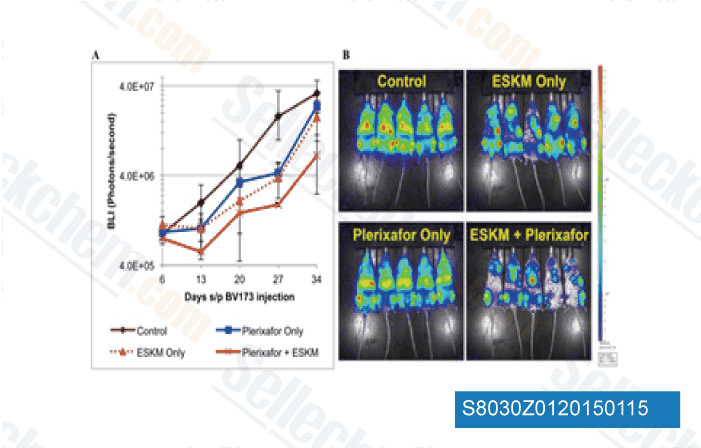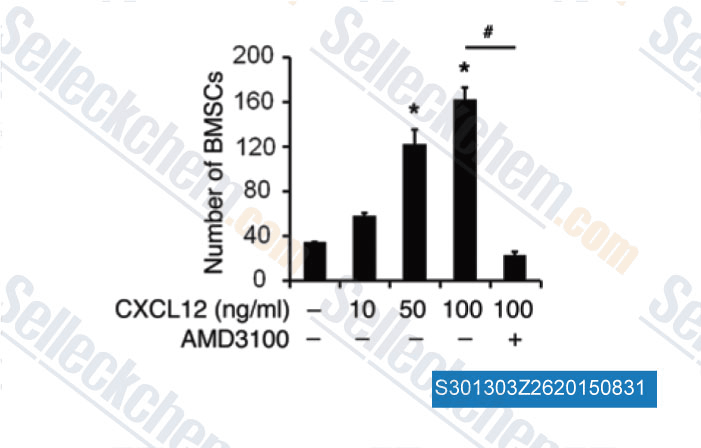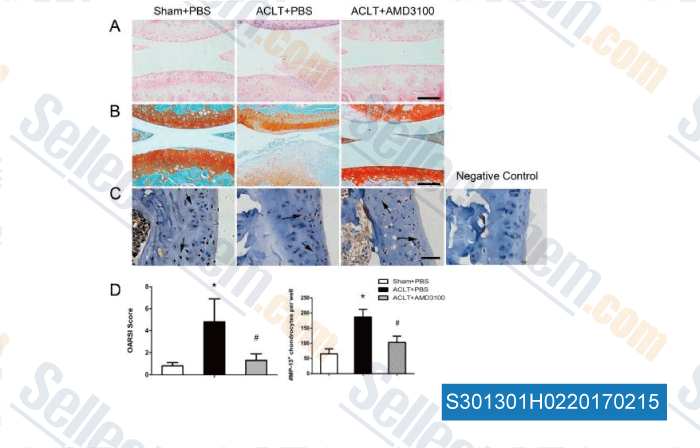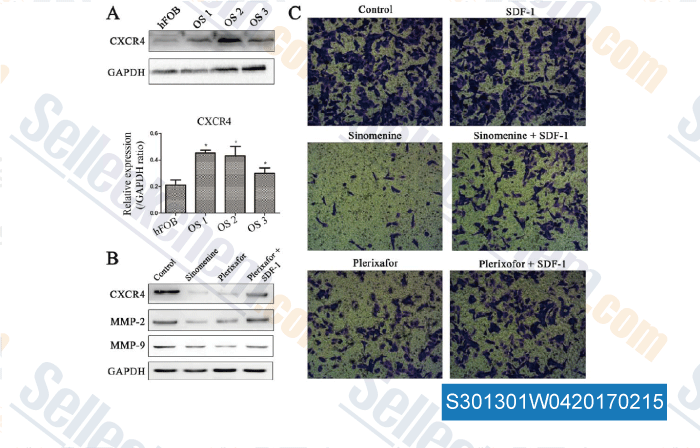|
Toll Free: (877) 796-6397 -- USA and Canada only -- |
Fax: +1-832-582-8590 Orders: +1-832-582-8158 |
Tech Support: +1-832-582-8158 Ext:3 Please provide your Order Number in the email. |
Technical Data
| Formula | C28H54N8.8HCl |
||||||
| Molecular Weight | 794.47 | CAS No. | 155148-31-5 | ||||
| Solubility (25°C)* | In vitro | Water | 100 mg/mL (125.87 mM) | ||||
| DMSO | Insoluble | ||||||
| Ethanol | Insoluble | ||||||
| In vivo (Add solvents to the product individually and in order) |
|
||||||
|
* <1 mg/ml means slightly soluble or insoluble. * Please note that Selleck tests the solubility of all compounds in-house, and the actual solubility may differ slightly from published values. This is normal and is due to slight batch-to-batch variations. * Room temperature shipping (Stability testing shows this product can be shipped without any cooling measures.) |
|||||||
Preparing Stock Solutions
Biological Activity
| Description | Plerixafor (AMD3100, JM 3100,Plerixafor Octahydrochloride,AMD3100 octahydrochloride,SID791 octahydrochloride) 8HCl is the hydrochloride of Plerixafor, a chemokine receptor antagonist for CXCR4 and CXCL12-mediated chemotaxis with IC50 of 44 nM and 5.7 nM in cell-free assays, respectively. Plerixafor can be used as an anti-HIV agent. | ||||
|---|---|---|---|---|---|
| Targets |
|
||||
| In vitro | Plerixafor inhibits CXCL12-mediated chemotaxis with a potency lightly better than its affinity for CXCR4. [1] Plerixafor also antagonizes SDF-1/CXCL12 ligand binding with an IC50 of 651 nM. Plerixafor inhibits SDF-1 mediated GTP-binding, SDF-1 mediated calcium flux and SDF-1 stimulated chemotaxis with IC50 of 27 nM, 572 nM and 51 nM, respectively. Plerixafor does not inhibit calcium flux against cells expressing CXCR3, CCR1, CCR2b, CCR4, CCR5 or CCR7 when stimulated with their cognate ligands, nor does Plerixafor inhibit receptor binding of LTB4. Plerixafor does not, on its own, induce a calcium flux in the CCRF–CEM cells, which express multiple GPCRs including CXCR4, CCR4 and CCR7. [2] |
||||
| In vivo | A single topical application of Plerixafor promotes wound healing in diabetic mice by increasing cytokine production, mobilizing bone marrow EPCs, and enhancing the activity of fibroblasts and monocytes/macrophages, thereby increasing both angiogenesis and vasculogenesis. [3] Cohorts of mice are administered with PBS, IGF1, PDGF, SCF, or VEGF for five consecutive days and Plerixafor on the 5th day. The number and size of the colonies are highest in IGF1 plus Plerixafor injected mice compared to PDGF, SCF and VEGF treated groups, in combination with Plerixafor. [4] |
Protocol (from reference)
| Animal Study: |
|
|---|
References
Customer Product Validation

-
Data from [Data independently produced by Blood, 2014, 123(21), 3296-304]

-
Data from [Data independently produced by , , J Clin Invest, 2015, 125(8): 3226-40]

-
Data from [Data independently produced by , , Int J Mol Sci, 2016, 17(6): 943.]

-
Data from [Data independently produced by , , Int J Oncol, 2016, 48(5):2098-112.]
Selleck's Plerixafor (AMD3100) 8HCl has been cited by 47 publications
| CXCL17 is an allosteric inhibitor of CXCR4 through a mechanism of action involving glycosaminoglycans [ Sci Signal, 2024, 17(828):eabl3758] | PubMed: 38502733 |
| Metformin potentiates nephrotoxicity by promoting NETosis in response to renal ferroptosis [ Cell Discov, 2023, 9(1):104] | PubMed: 37848438 |
| Metformin potentiates nephrotoxicity by promoting NETosis in response to renal ferroptosis [ Cell Discov, 2023, 9(1):104] | PubMed: 37848438 |
| Vascular regeneration and skeletal muscle repair induced by long-term exposure to SDF-1α derived from engineered mesenchymal stem cells after hindlimb ischemia [ Exp Mol Med, 2023, 10.1038/s12276-023-01096-9] | PubMed: 37779148 |
| PDGF-BB is involved in HIF-1α/CXCR4/CXCR7 axis promoting capillarization of hepatic sinusoidal endothelial cells [ Heliyon, 2023, 9(1):e12715] | PubMed: 36685431 |
| Targeting CXCR4 abrogates resistance to trastuzumab by blocking cell cycle progression and synergizes with docetaxel in breast cancer treatment [ Res Sq, 2023, rs.3.rs-2388864] | PubMed: 36824840 |
| Targeting CXCR4 abrogates resistance to trastuzumab by blocking cell cycle progression and synergizes with docetaxel in breast cancer treatment [ Res Sq, 2023, rs.3.rs-2388864] | PubMed: 36824840 |
| Targeting vasoactive intestinal peptide-mediated signaling enhances response to immune checkpoint therapy in pancreatic ductal adenocarcinoma [ Nat Commun, 2022, 13(1):6418] | PubMed: 36302761 |
| Atypical chemokine receptor 3 induces colorectal tumorigenesis in mice by promoting β-arrestin-NOLC1-fibrillarin-dependent rRNA biogenesis [ Acta Pharmacol Sin, 2022, 10.1038/s41401-022-00901-x] | PubMed: 35365782 |
| MIF/CXCR4 signaling axis contributes to survival, invasion, and drug resistance of metastatic neuroblastoma cells in the bone marrow microenvironment [ BMC Cancer, 2022, 22(1):669] | PubMed: 35715791 |
RETURN POLICY
Selleck Chemical’s Unconditional Return Policy ensures a smooth online shopping experience for our customers. If you are in any way unsatisfied with your purchase, you may return any item(s) within 7 days of receiving it. In the event of product quality issues, either protocol related or product related problems, you may return any item(s) within 365 days from the original purchase date. Please follow the instructions below when returning products.
SHIPPING AND STORAGE
Selleck products are transported at room temperature. If you receive the product at room temperature, please rest assured, the Selleck Quality Inspection Department has conducted experiments to verify that the normal temperature placement of one month will not affect the biological activity of powder products. After collecting, please store the product according to the requirements described in the datasheet. Most Selleck products are stable under the recommended conditions.
NOT FOR HUMAN, VETERINARY DIAGNOSTIC OR THERAPEUTIC USE.
